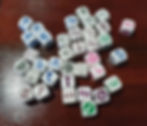Story cubes and what is really happening beneath the surface
- Sharon du Preez
- Jun 15, 2022
- 3 min read

I have 4 sets of story cubes in my play therapy room and use them quite often with kids. The way it works is that we each take turns picking up a picture that has landed face up and we make up a piece of a story and slowly build a cohesive story together out of all 36 dice. I usually encourage the child to be wild and imaginative. Cognitively, this requires the child to be able to listen to what I added and remember the gist of the story when they add their pieces, it is good for language development, it encourages creativity and imagination and it involves patience and turn taking. Those are not my goals, but they are benefits, nonetheless.
Therapeutically, there are a few things happening beneath the surface. Firstly, there is the relational aspect. We are playing together. I am listening intently to what the child is saying. If asked to, I will remember the entire story, including every detail the child added along the way, when we get to the end. Failure to do that would show the child that I wasn't listening, wasn't fully present and didn't care. I can't afford to fail in remembering all of it. If the child asks me to retell the whole story after we are done taking our turns, I have to be able to do that. When I do, the child knows I was paying full attention to them and listening and I care enough to hold all of the detail they gave me. If I can do that with a silly game, then I can do that with anything else they share with me. It builds trust and relationship. The whole basis of play therapy lies in the relationship, so any opportunity I get to build a relationship with the child, I take very seriously.
Then there is the symbolism in the story being told, and then being reshuffled and put away, or left behind in the play therapy room. We do that with their silly story and later, when they trust me, we will do that with their own difficult story.
I am always listening to the elements the child adds to the story. The first time we play it, I will just follow the child's lead and expand the story along whatever the child is introducing. So, if the story is full of problems, I might expand the problems and see what the child does. If the story is full of heroes doing good things, I will keep going with that. Usually, the first time we play it, I am trying to feel out where the child is at, while also trying to make the story wild and fun. Thereafter, I will use the story to intervene in subtle ways. A particularly negative child may introduce many problems, so when I get my turn, there will always be positive outcomes and solutions. An emotional child might bring a lot of emotional elements into the story. I may either expand on that so that we explore those emotions more or I might introduce solutions to those emotions. At the very least, I will make it clear with my additions that those emotions are ok. A child who is a bit depressed might struggle to be creative so I will make the story wild and throw in the weirdest things I can think of, to stimulate the child into switching out of their current state of mind. I am also listening for content that relates to the child's presenting problem, so that I can intervene there. If a child struggles to express anything, my turns will express either the things I think the child would want to express or perhaps I will express something of my own to help the child build trust.
Narrative games like this are great. There is much scope for intervention, expression, development and also fun and laughter. Many a child has come in cranky and left in a better headspace, simply by playing this game. I love it for the relational aspects and I love it for the therapeutic benefits. It is also great for keeping my own memory honed because heaven forbid I ever forget a detail a child adds.... they WILL let me know about it! Simple game. So much more going on under the surface than is obvious when you are just observing from the outside!
